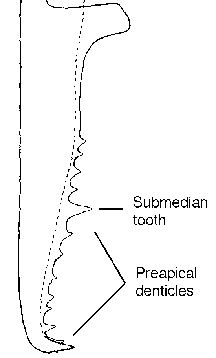

Dacetonini, Myrmicinae, Formicidae, Hymenoptera, Insecta, Arthropoda, Animalia
John T. Longino
The Evergreen State College
Olympia WA 98505 USA
longinoj@evergreen.edu
23 April 1997
| Key to Costa Rican species of Neostruma | Species List |
The dacetonines are a diverse lineage found throughout the world. Many species are known to be strictly predaceous, and all are assumed to be. Most of them have highly modified mandibles relative to the standard triangular mandible common to most other ants. Many have mandibles that are elongate, linear, and with opposing tines at the tip (convergent with other lineages such as Odontomachus in the Ponerinae). Others have elongate mandibles like serrated scissors. Others have serrated mandibles that curve ventrally. Most dacetonines are slow-moving, small, and very cryptic. Most are found in or under rotten wood, and in the leaf litter. Dacetonines are difficult to locate by visual search, but litter sifting followed by extraction in Winkler bags or Berlese funnels often yields abundant material.
The dacetonine genera currently known for Costa Rica are Acanthognathus, Glamyromyrmex, Neostruma, Smithistruma, Strumigenys, and Trichoscapa. I avoid giving details of generic definitions here, because Barry Bolton of the British Museum is currently revising "smithistrumiform" dacetonines, and the generic definitions will change dramatically.
Neostruma was last revised by Brown (1959). Below is a key to the known Costa Rican species of the genus Neostruma. All of the material on which the key was based was sent to Bolton and verified by him.
Key to Costa Rican Neostruma (first couplet)


10b. Preapical denticles all of similar size or gradually decreasing in size; mesosomal dorsum flatter, propodeal suture moderately impressed; total head length < 0.90mm in most species, > 0.90mm in one rare species: 20

20b. Total head length < 0.90mm; mandibular denticles variable, but usually fewer; eyes relatively smaller, fewer than 15 facets: 30
30a. Vertex with prominent transverse ridge: aethegenys (rare)
30b. Vertex lacking transverse ridge: 40

40a. Color light yellow-brown; pair of mesonotal setae short and inconspicuous, tilted rearward; approximately 6 preapical denticles: zeteki
40b. Color red-brown to dark brown; pair of mesonotal setae conspicuous, often erect or tilted forward; approximately 5 or fewer preapical denticles.....50

50a. Total head length < 0.72mm; color light brown; mesonotal setae usually spatulate: brevicornis (light form)
50b. Total head length > 0.75mm; color red-brown to dark brown; mesonotal setae often relatively more filiform: brevicornis (dark form)

Literature Cited
Brown, W. L., Jr. 1959. A revision of the Dacetine ant genus Neostruma. Breviora 107:1-13.